PORSCHE CAYNNE S 2005 1.G Owners Manual
Manufacturer: PORSCHE, Model Year: 2005, Model line: CAYENNE S, Model: PORSCHE CAYENNE S 2005 1.GPages: 380, PDF Size: 3.17 MB
Page 301 of 380
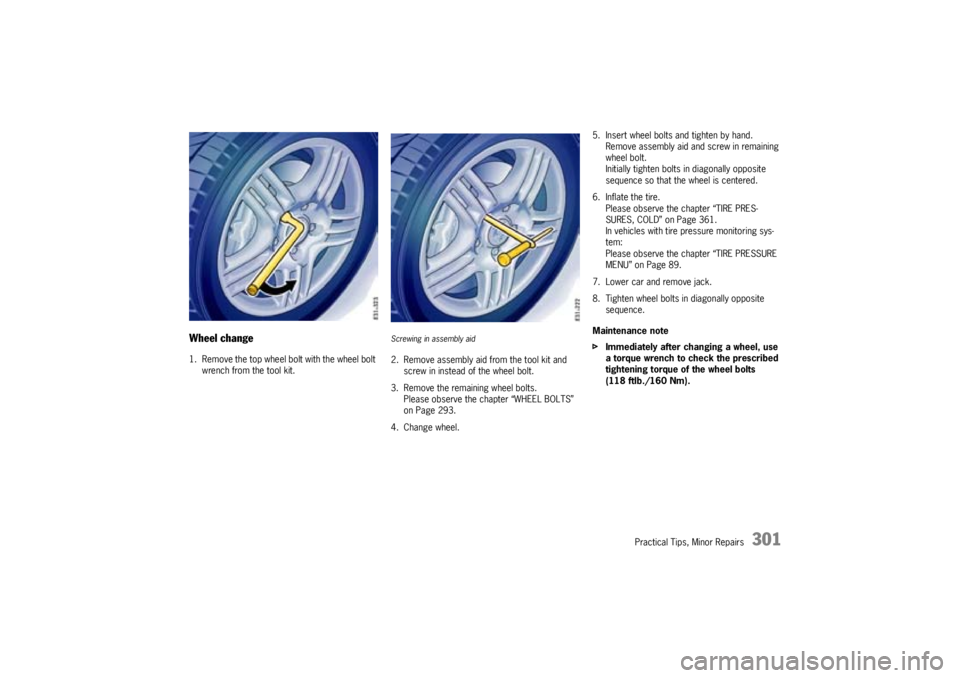
Practical Tips, Minor Repairs
301
Wheel change1. Remove the top wheel bolt with the wheel bolt
wrench from the tool kit.
Screwing in assembly aid 2. Remove assembly aid from the tool kit and
screw in instead of the wheel bolt.
3. Remove the remaining wheel bolts.
Please observe the chapter “WHEEL BOLTS”
on Page 293.
4. Change wheel.5. Insert wheel bolts and tighten by hand.
Remove assembly aid and screw in remaining
wheel bolt.
Initially tighten bolts in diagonally opposite
sequence so that the wheel is centered.
6. Inflate the tire.
Please observe the chapter “TIRE PRES-
SURES, COLD” on Page 361.
In vehicles with tire pressure monitoring sys-
tem:
Please observe the chapter “TIRE PRESSURE
MENU” on Page 89.
7. Lower car and remove jack.
8. Tighten wheel bolts in diagonally opposite
sequence.
Maintenance note
fImmediately after changing a wheel, use
a torque wrench to check the prescribed
tightening torque of the wheel bolts
(118 ftlb./160 Nm).
Page 302 of 380
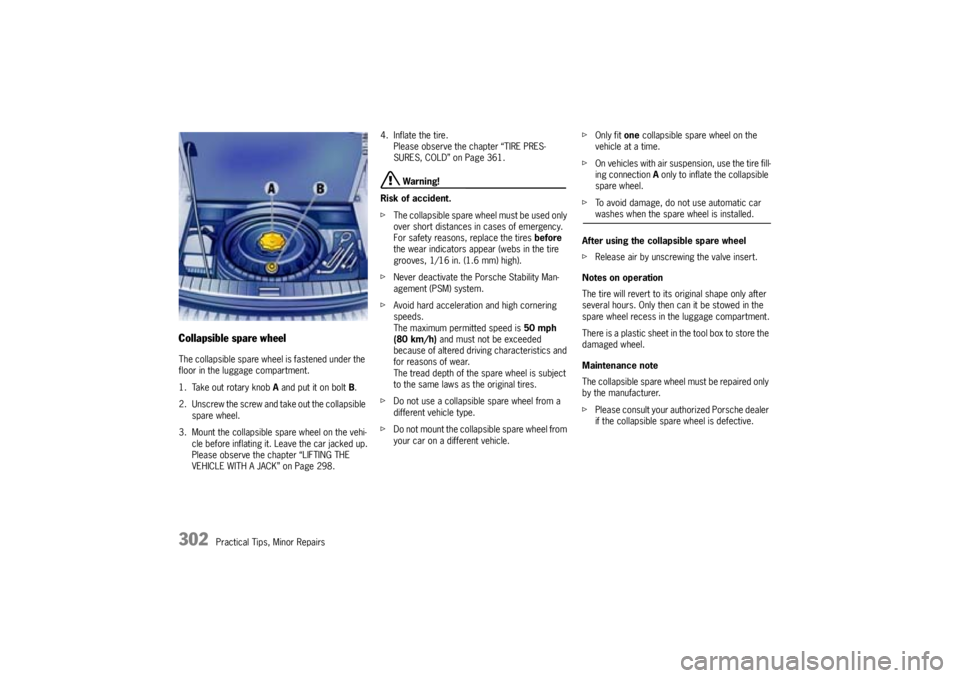
302
Practical Tips, Minor Repairs
Collapsible spare wheelThe collapsible spare wheel is fastened under the
floor in the luggage compartment.
1. Take out rotary knob A and put it on bolt B.
2. Unscrew the screw and take out the collapsible
spare wheel.
3. Mount the collapsible spare wheel on the vehi-
cle before inflating it. Leave the car jacked up.
Please observe the chapter “LIFTING THE
VEHICLE WITH A JACK” on Page 298.4. Inflate the tire.
Please observe the chapter “TIRE PRES-
SURES, COLD” on Page 361.
Warning!
Risk of accident.
fThe collapsible spare wheel must be used only
over short distances in cases of emergency.
For safety reasons, replace the tires before
the wear indicators appear (webs in the tire
grooves, 1/16 in. (1.6 mm) high).
fNever deactivate the Porsche Stability Man-
agement (PSM) system.
fAvoid hard acceleration and high cornering
speeds.
The maximum permitted speed is 50 mph
(80 km/h) and must not be exceeded
because of altered driving characteristics and
for reasons of wear.
The tread depth of the spare wheel is subject
to the same laws as the original tires.
fDo not use a collapsible spare wheel from a
different vehicle type.
fDo not mount the collapsible spare wheel from
your car on a different vehicle.fOnly fit one collapsible spare wheel on the
vehicle at a time.
fOn vehicles with air suspension, use the tire fill-
ing connection A only to inflate the collapsible
spare wheel.
fTo avoid damage, do not use automatic car
washes when the spare wheel is installed.
After using the collapsible spare wheel
fRelease air by unscrewing the valve insert.
Notes on operation
The tire will revert to its original shape only after
several hours. Only then can it be stowed in the
spare wheel recess in the luggage compartment.
There is a plastic sheet in the tool box to store the
damaged wheel.
Maintenance note
The collapsible spare wheel must be repaired only
by the manufacturer.
fPlease consult your authorized Porsche dealer
if the collapsible spare wheel is defective.
Page 303 of 380
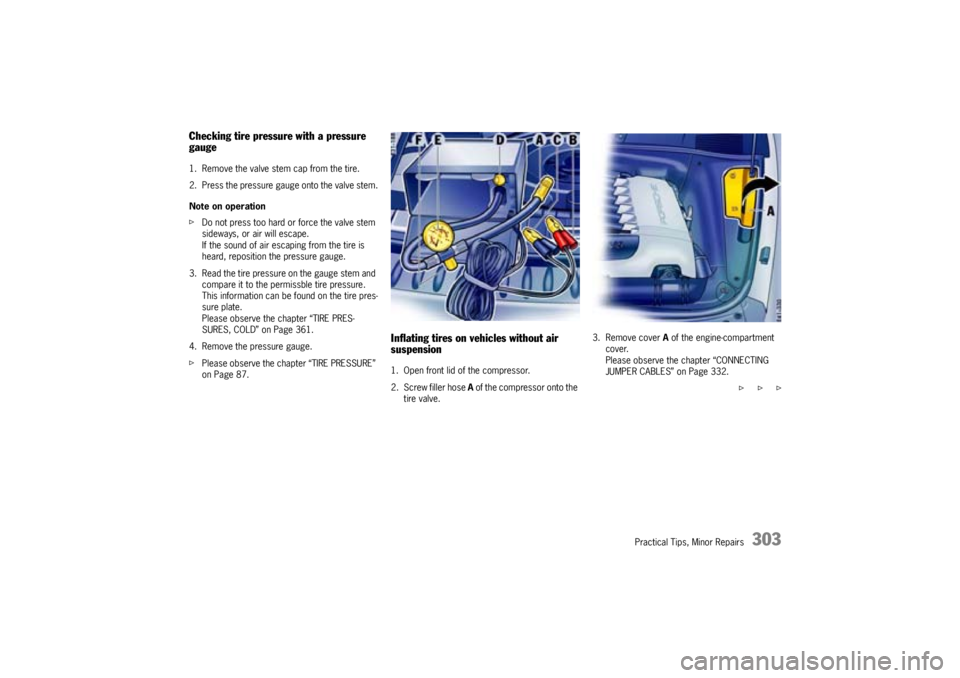
Practical Tips, Minor Repairs
303
Checking tire pressure with a pressure
gauge1. Remove the valve stem cap from the tire.
2. Press the pressure gauge onto the valve stem.
Note on operation
fDo not press too hard or force the valve stem
sideways, or air will escape.
If the sound of air escaping from the tire is
heard, reposition the pressure gauge.
3. Read the tire pressure on the gauge stem and
compare it to the permissble tire pressure.
This information can be found on the tire pres-
sure plate.
Please observe the chapter “TIRE PRES-
SURES, COLD” on Page 361.
4. Remove the pressure gauge.
fPlease observe the chapter “TIRE PRESSURE”
on Page 87.
Inflating tires on vehicles without air
suspension1. Open front lid of the compressor.
2. Screw filler hose A of the compressor onto the
tire valve.3. Remove cover A of the engine-compartment
cover.
Please observe the chapter “CONNECTING
JUMPER CABLES” on Page 332.
f f f
Page 304 of 380
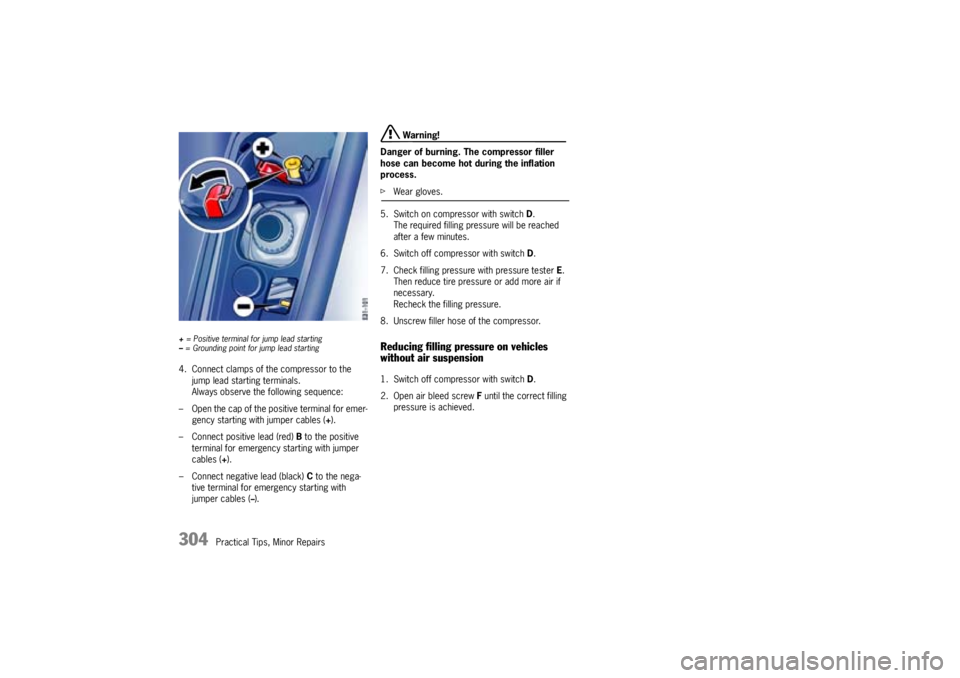
304
Practical Tips, Minor Repairs
+ = Positive terminal for jump lead starting
– = Grounding point for jump lead starting4. Connect clamps of the compressor to the
jump lead starting terminals.
Always observe the following sequence:
– Open the cap of the positive terminal for emer-
gency starting with jumper cables (+).
– Connect positive lead (red) B to the positive
terminal for emergency starting with jumper
cables (+).
– Connect negative lead (black) C to the nega-
tive terminal for emergency starting with
jumper cables (
–).
Warning!
Danger of burning. The compressor filler
hose can become hot during the inflation
process.
fWear gloves.
5. Switch on compressor with switch D.
The required filling pressure will be reached
after a few minutes.
6. Switch off compressor with switch D.
7. Check filling pressure with pressure tester E.
Then reduce tire pressure or add more air if
necessary.
Recheck the filling pressure.
8. Unscrew filler hose of the compressor.Reducing filling pressure on vehicles
without air suspension1. Switch off compressor with switch D.
2. Open air bleed screw F until the correct filling
pressure is achieved.
Page 305 of 380
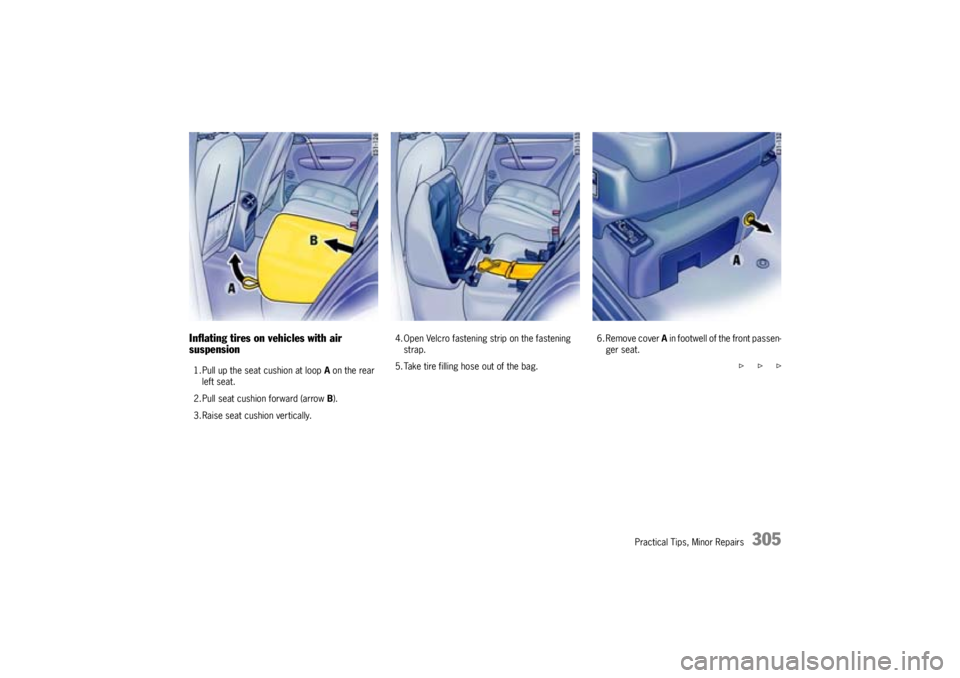
Practical Tips, Minor Repairs
305
Inflating tires on vehicles with air
suspension1. Pull up the seat cushion at loop A on the rear
left seat.
2. Pull seat cushion forward (arrow B).
3. Raise seat cushion vertically.4. Open Velcro fastening strip on the fastening
strap.
5. Take tire filling hose out of the bag.6. Remove cover A in footwell of the front passen-
ger seat.
f f f
Page 306 of 380
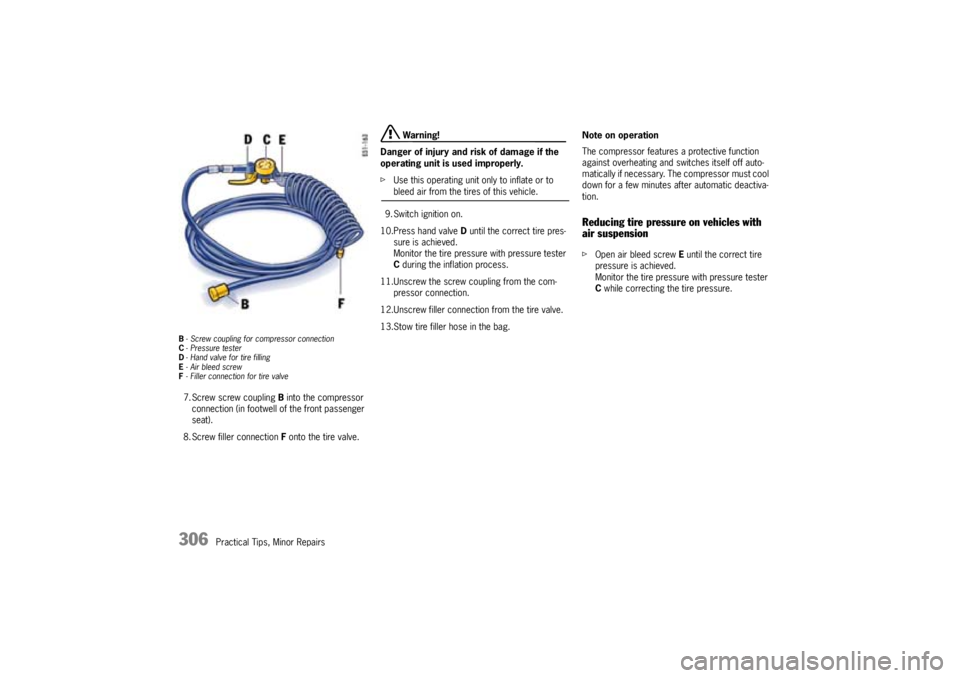
306
Practical Tips, Minor Repairs
B- Screw coupling for compressor connection
C- Pressure tester
D- Hand valve for tire filling
E- Air bleed screw
F- Filler connection for tire valve7. Screw screw coupling B into the compressor
connection (in footwell of the front passenger
seat).
8. Screw filler connection F onto the tire valve.
Warning!
Danger of injury and risk of damage if the
operating unit is used improperly.
fUse this operating unit only to inflate or to bleed air from the tires of this vehicle.
9. Switch ignition on.
10.Press hand valve Duntil the correct tire pres-
sure is achieved.
Monitor the tire pressure with pressure tester
C during the inflation process.
11.Unscrew the screw coupling from the com-
pressor connection.
12.Unscrew filler connection from the tire valve.
13.Stow tire filler hose in the bag.Note on operation
The compressor features a protective function
against overheating and switches itself off auto-
matically if necessary. The compressor must cool
down for a few minutes after automatic deactiva-
tion.
Reducing tire pressure on vehicles with
air suspensionfOpen air bleed screw E until the correct tire
pressure is achieved.
Monitor the tire pressure with pressure tester
C while correcting the tire pressure.
Page 307 of 380
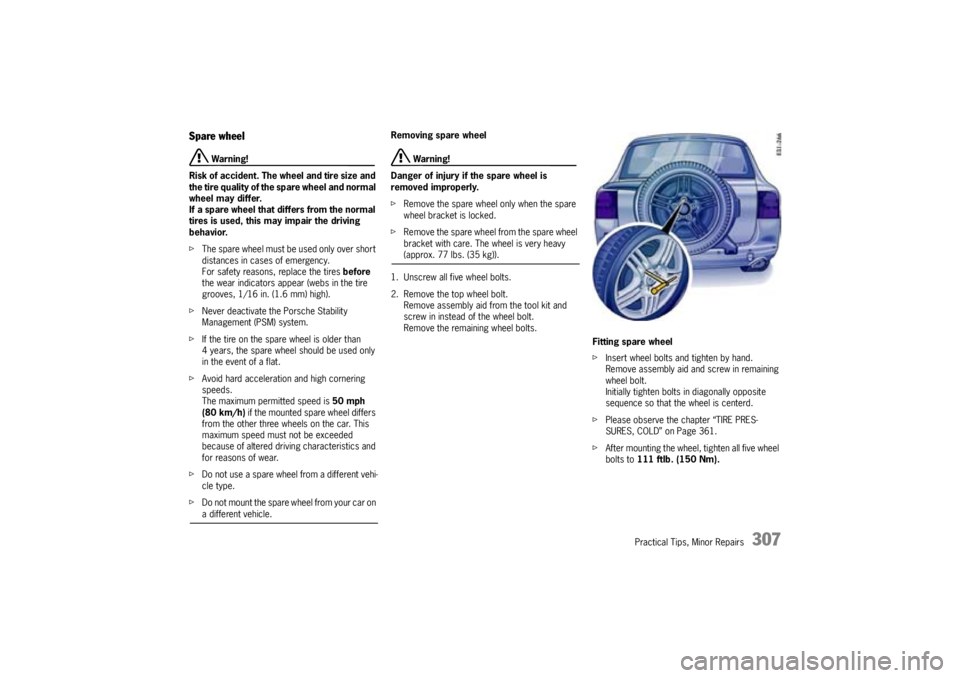
Practical Tips, Minor Repairs
307
Spare wheel
Warning!
Risk of accident. The wheel and tire size and
the tire quality of the spare wheel and normal
wheel may differ.
If a spare wheel that differs from the normal
tires is used, this may impair the driving
behavior.
fThe spare wheel must be used only over short
distances in cases of emergency.
For safety reasons, replace the tires before
the wear indicators appear (webs in the tire
grooves, 1/16 in. (1.6 mm) high).
fNever deactivate the Porsche Stability
Management (PSM) system.
fIf the tire on the spare wheel is older than
4 years, the spare wheel should be used only
in the event of a flat.
fAvoid hard acceleration and high cornering
speeds.
The maximum permitted speed is 50 mph
(80 km/h) if the mounted spare wheel differs
from the other three wheels on the car. This
maximum speed must not be exceeded
because of altered driving characteristics and
for reasons of wear.
fDo not use a spare wheel from a different vehi-
cle type.
fDo not mount the spare wheel from your car on a different vehicle.Removing spare wheel
Warning!
Danger of injury if the spare wheel is
removed improperly.
fRemove the spare wheel only when the spare
wheel bracket is locked.
fRemove the spare wheel from the spare wheel
bracket with care. The wheel is very heavy (approx. 77 lbs. (35 kg)).
1. Unscrew all five wheel bolts.
2. Remove the top wheel bolt.
Remove assembly aid from the tool kit and
screw in instead of the wheel bolt.
Remove the remaining wheel bolts.
Fitting spare wheel
fInsert wheel bolts and tighten by hand.
Remove assembly aid and screw in remaining
wheel bolt.
Initially tighten bolts in diagonally opposite
sequence so that the wheel is centerd.
fPlease observe the chapter “TIRE PRES-
SURES, COLD” on Page 361.
fAfter mounting the wheel, tighten all five wheel
bolts to 111 ftlb. (150 Nm).
Page 308 of 380
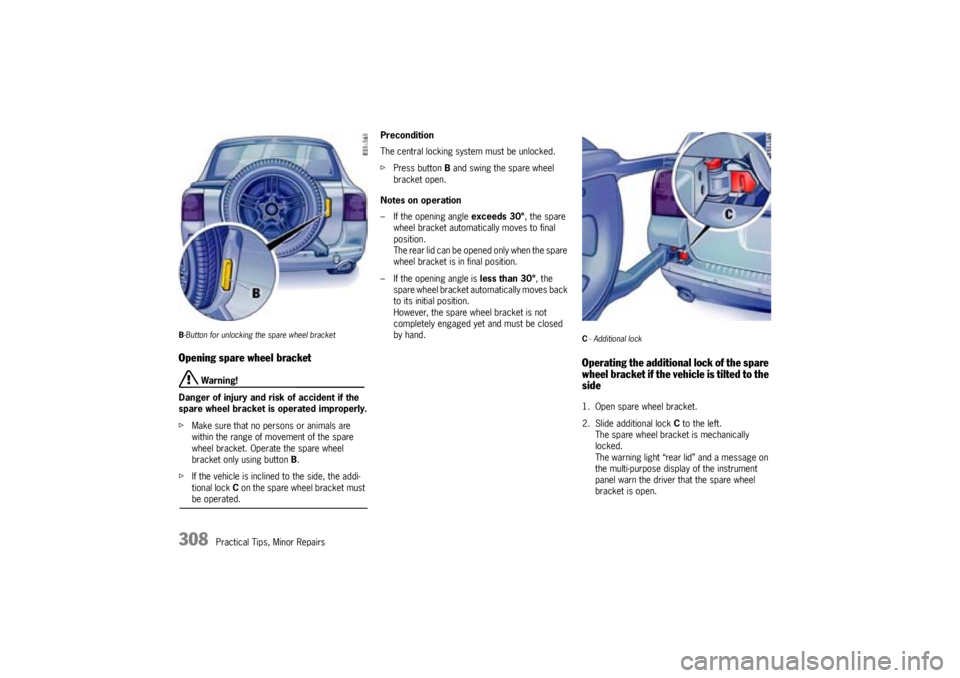
308
Practical Tips, Minor Repairs
B-Button for unlocking the spare wheel bracketOpening spare wheel bracket
Warning!
Danger of injury and risk of accident if the
spare wheel bracket is operated improperly.
fMake sure that no persons or animals are
within the range of movement of the spare
wheel bracket. Operate the spare wheel
bracket only using button B.
fIf the vehicle is inclined to the side, the addi-
tional lock C on the spare wheel bracket must be operated.Precondition
The central locking system must be unlocked.
fPress button B and swing the spare wheel
bracket open.
Notes on operation
– If the opening angle exceeds 30°, the spare
wheel bracket automatically moves to final
position.
The rear lid can be opened only when the spare
wheel bracket is in final position.
– If the opening angle is less than 30°, the
spare wheel bracket automatically moves back
to its initial position.
However, the spare wheel bracket is not
completely engaged yet and must be closed
by hand.
C- Additional lock Operating the additional lock of the spare
wheel bracket if the vehicle is tilted to the
side1. Open spare wheel bracket.
2. Slide additional lock C to the left.
The spare wheel bracket is mechanically
locked.
The warning light “rear lid” and a message on
the multi-purpose display of the instrument
panel warn the driver that the spare wheel
bracket is open.
Page 309 of 380
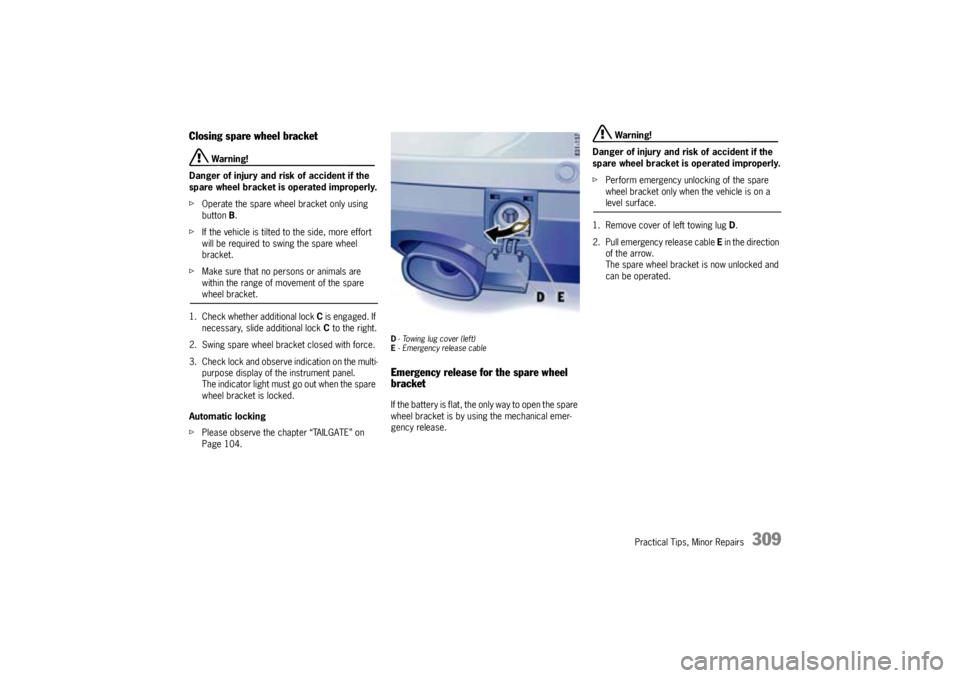
Practical Tips, Minor Repairs
309
Closing spare wheel bracket
Warning!
Danger of injury and risk of accident if the
spare wheel bracket is operated improperly.
fOperate the spare wheel bracket only using
buttonB.
fIf the vehicle is tilted to the side, more effort
will be required to swing the spare wheel
bracket.
fMake sure that no persons or animals are
within the range of movement of the spare wheel bracket.
1. Check whether additional lock C is engaged. If
necessary, slide additional lock C to the right.
2. Swing spare wheel bracket closed with force.
3. Check lock and observe indication on the multi-
purpose display of the instrument panel.
The indicator light must go out when the spare
wheel bracket is locked.
Automatic locking
fPlease observe the chapter “TAILGATE” on
Page 104.
D- Towing lug cover (left)
E- Emergency release cableEmergency release for the spare wheel
bracketIf the battery is flat, the only way to open the spare
wheel bracket is by using the mechanical emer-
gency release.
Warning!
Danger of injury and risk of accident if the
spare wheel bracket is operated improperly.
fPerform emergency unlocking of the spare
wheel bracket only when the vehicle is on a level surface.
1. Remove cover of left towing lug D.
2. Pull emergency release cable E in the direction
of the arrow.
The spare wheel bracket is now unlocked and
can be operated.
Page 310 of 380
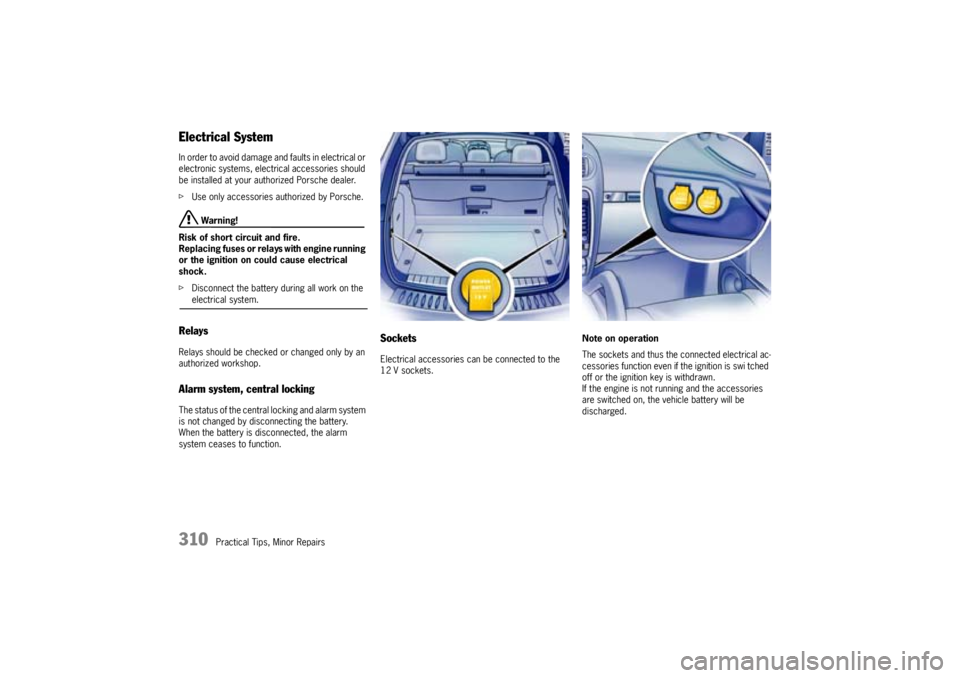
310
Practical Tips, Minor Repairs
Electrical SystemIn order to avoid damage and faults in electrical or
electronic systems, electrical accessories should
be installed at your authorized Porsche dealer.
fUse only accessories authorized by Porsche.
Warning!
Risk of short circuit and fire.
Replacing fuses or relays with engine running
or the ignition on could cause electrical
shock.
fDisconnect the battery during all work on the electrical system.
RelaysRelays should be checked or changed only by an
authorized workshop.Alarm system, central lockingThe status of the central locking and alarm system
is not changed by disconnecting the battery.
When the battery is disconnected, the alarm
system ceases to function.
SocketsElectrical accessories can be connected to the
12 V sockets.Note on operation
The sockets and thus the connected electrical ac-
cessories function even if the ignition is swi tched
off or the ignition key is withdrawn.
If the engine is not running and the accessories
are switched on, the vehicle battery will be
discharged.